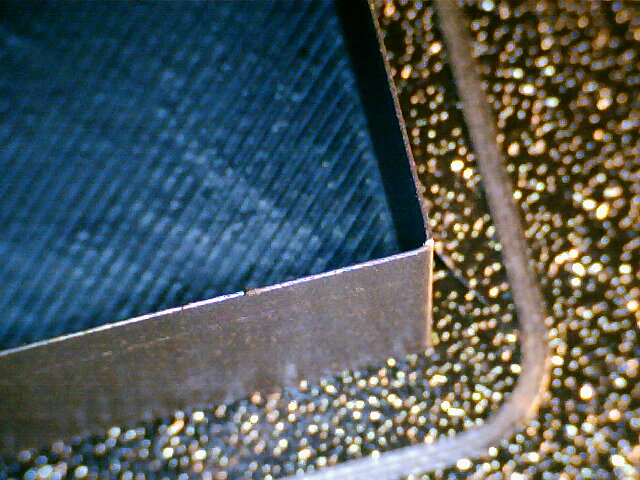I built my 3D printer a couple of months ago, but I can’t get it to print sharp corners. The corners in the picture should be 90°, without any fillets:

During this test print, I played with multiple parameters: speed, temperature, acceleration, junction deviation, linear advance. All of these were also individually tuned previously. Nothing seems to make a difference.
Could this be a issue with the construction of my printer? I’m beginning to think my hotend isn’t rigid enough, but then I would at least expect better results at low speeds.
Edit: the printer is a CoreXY of my own design running Marlin 2.1.2.1. The Slicer is PrusaSlicer with most settings left as default (but increased speeds)
So, 3d prints will always have a radius on corners that is roughly equal to half the extrusion width. This is because the nozzles are circular, and the plastic comes out in a circular cross section.
From what I can tell on the picture of your part, you have a relatively wide extrusion width set up. what’s the sliced width? what’s the size of your nozzle?
If you want very sharp corners, you’ll need to drop down to a smaller nozzle diameter to maintain other aspects of print quality- generally extrusion widths should be at least the width of the nozzle. The reason being is that your printer relies on getting good ‘squish’ to keep the layers adhering stronger, and the way a printer gets narrower extrusion widths is by ‘stretching’ the filament along, which kind of weakens things.
If you’re using prusa slicer, it’s a simple matter to reduce EW specifically on external perimeters and get a nice print without sacrificing too much in the way of strength, but if the difference between internal perimeters and external perimeters are too large… things may go wonky. at that point, it might be prudent to drop down to a smaller nozzle diameter. (which prints things slower.)
A minor word of warning, however. Fillets and chamfers are important aspects of design. having sharp corners looks good, sure, but putting a fillet or chamfer on an internal corner makes a stronger part.
The part is just pretty small, I have the EW set to 0.45 mm withe 0.4 nozzle. But I will try turning it down further.
The rounding looks much more extreme than what I would expect or have seen on other printers I worked with (mostly Ultimakers).
Huh. Maybe it’s just the perspective, it looked maybe closer to .6mm.
Just to verify, you’ve checked that the printer extrudes .45mm of width when called? (Tuning extruder esteps and extrusion multiplier, and double checking filament diameter,)?
As a sanity check, I’d compare the overall width of the part to what you were expecting.
One thing that concerns me for the inside corners along the side… Why is your slicer cutting an angle across that corner instead of making a sharp turn (see the yellow lines in the slicer image)? Most prints draw the inside lines first and the outside perimeter last, so if you have a diagonal line sitting there already then there’s no possible way to force a square corner there.
Sorry for the lack of terminology, it’s been awhile since I fired up my printer, but I know in Cura under the speed settings there are parameters to set how fast the head goes from zero to full speed, and if you disable this then the head doesn’t have time to slow down at the corner before launching off in another direction which causes rounded outside corners like you show on the end of your print. I’m sure someone else can jog my memory about what this is called, but it would be worthwhile to check this in your Prusa settings as well.
Regardless, you’re not going to get ‘sharp’ corners. My printer has a 0.4mm nozzle and even with decent settings and a slower speed I still get corners roughly twice that diameter, so don’t expect your print to match what’s drawn on the screen.
I’ve only used prusa slicer, which is what it looks like OP is using, and it results in printing perimeters first, then inside.
Ah interesting. On Cura you can change whether you do the perimeter or infill last, but I always found doing the perimeter last creates smother detail. Makes me wonder why Prusa decided to go the other direction, but I guess whatever works…
Prusa has that option too. It does perimeter last by default because that’s safer when you have overhangs. It gives the external perimeter something more to stick too and not sag. In extreme cases it can even lead to printing disconnected overhangs first like the inner perimeter of a vertical screw hole which just weld to your support and make a mess.
External perimeter first does provide more detail though (specifically dimensional accuracy in the prusa help) and can avoid some artifacts so if it’s safe for your part it’s nice.
I can only add 2 things that I know of here that could help.
#1.Try a linear advance tune. That alone should give you sharper corners and more consistent details at higher print speeds.
https://marlinfw.org/docs/features/lin_advance.html
#2.A direct extruder can help with getting very precise sharp corners but from what I understand it will hurt with accuracy on curves. Also there is the whole fact that there is a motor on top of the hot end so weight and whatnot will hurt speed.
Anyway just check out #1. It should help with your issue. If not that then a feed rate tune would solve any over extrusion problems.
Regarding #2, not having to sling a 1-2lb bed back and forth with the CoreXY construction should cancel out most any loss from using a DD extruder.
What printer, what slicer, what settings, what filament would help people give you assistance.
Good point, see my edit
Try klipper and tuning your pressure advanced. https://www.klipper3d.org/Pressure_Advance.html
Double check your temperature, speed, and calibration.
With low quality filament I get a lot of dribble, and with high speeds it all pools up in the corners and bulges them out.
That might be part of it, my filament is probably pretty wet. I’ll try some other rolls of filament.
Id like to see a single wall cube print like 30x30 mm. Corners on the picture look rounded too much, but wall thickness is only 1.35 mm (right?). In ideal world you would have R0.225 on each corner so the flat part would be only 0.9 mm. Thats super small, you probably want smaller nozzle for details like that. But yeah, maybe it can be improved by tuning settings or reducing play in your XY gantry
This is a 40x40 cube printed in vase mode:

The corners look pretty okay on that:

But I don’t see these kind of results on real-world parts. I guess I have to print some more test parts to narrow down the problem.
Cube looks good, but corners are rounded bit too much I think (at least the one on 2nd pic)
Your design CoreXY reminds me on belt issues. Do you have a pic? It doesnt have to be mechanical issue, but belts must be tight and parallel/perpendicular to linear motion system.

The belts are parallel to the axis, but I will try tightening them some more.
It looks great. Ive seen some bad designs with weird belt paths, but not your case
Tightening the belts seems to have helped, but I will have to do some more printing to be sure. Thanks for your help!
Great to hear that
New Lemmy Post: What is causing rounded Corners on my prints? (https://lemmy.world/post/11228489)
Tagging: #3dprinting(Replying in the OP of this thread (NOT THIS BOT!) will appear as a comment in the lemmy discussion.)
I am a FOSS bot. Check my README: https://github.com/db0/lemmy-tagginator/blob/main/README.md
Rounded corners like this makes me think that you have Klipper’s Resonance Compensation feature overtuned, but you’d have to really be trying to get it this bad. What printer and firmware are you using?
It’s a printer of my own design running marlin. I’m going to try disabling input shaping, but if I remember correctly the problem was already there before I ever enabled it.
Input shaping shouldn’t be the problem, it’s mainly there to limit ringing. I’m not sure what marlin calls it but if you were using klipper I’d say you need to tune your pressure advance.
Just throwing it out there cause I don’t think it’s been mentioned, but could it be possible your belts aren’t tight enough? I could see something like this happening if they slip a bit when trying to suddenly change direction.
what happens if you try just moving it 10mm, is it going the expected distance at the expected pace?



